Home » SWICo Papers (Page 4)
Category Archives: SWICo Papers
Neural network based model for global Total Electron Content forecasting
Papers from SWICo members
Claudio Cesaroni, Luca Spogli, Angela Aragon-Angel, Michele Fiocca, Varuliator Dear, Giorgiana De Franceschi, Vincenzo Romano
We describe a novel empirical model to forecast, one day in advance, the Total Electron Content (TEC) at global scale. The technique is based on the Global Ionospheric Map (GIM), provided by the International GNSS Service (IGS), and exploits a nonlinear autoregressive neural network with external input (NARX) applied to selected TEC time series for soma particular GIM grid points (24 h single-point TEC forecasting), taking into account the actual and forecasted geomagnetic conditions. To extend the forecasting at a global scale, the technique leverages of the NeQuick2 Model fed by an effective sunspot number R12 (R12eff), calculated by minimizing the root mean square error (RMSE) between NARX output and NeQuick2 applied at the same GIM grid points. This new approach is able to reproduce the behavior of the ionosphere especially during disturbed periods.
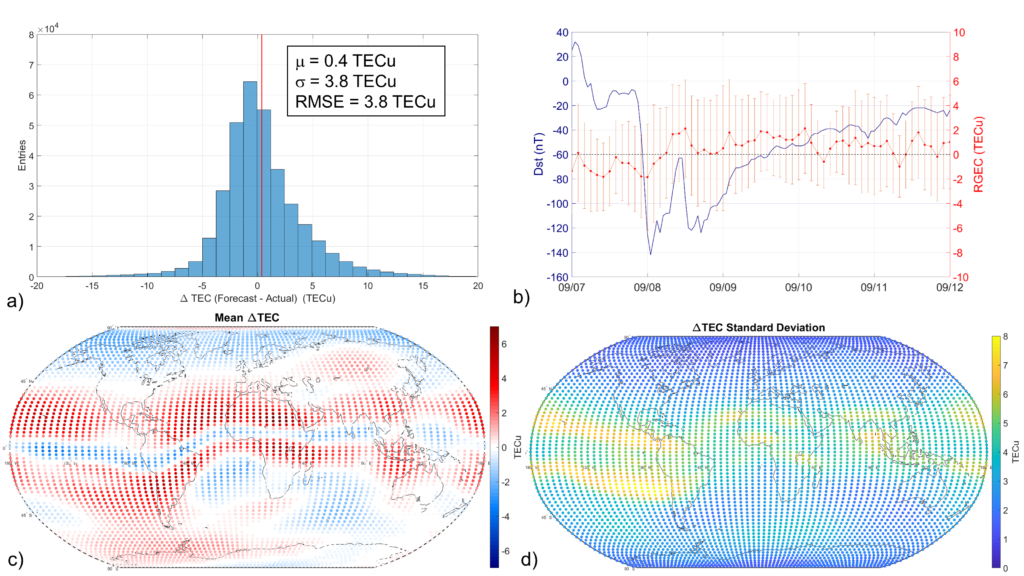
The performance of the forecasting model is extensively validated under different geospatial conditions, against both TEC maps products by UPC (Universitat Politècnica de Catalunya) and independent TEC data from Jason-3 spacecraft. The validation gives very satisfactory results in terms of RMSE, as it has been found to range between 3 and 5 TECu. RMSE depend on the latitude sectors, time of the day, geomagnetic conditions, and provide a statistical estimation of the accuracy of the 24-h forecasting technique even over the areas poorly covered by GNSS receivers (i.e. the oceans). The validation of the forecasting during five geomagnetic storms reveals that the model performance is not deteriorated during disturbed periods. This 24-h empirical approach is currently implemented on the Ionosphere Prediction Service (IPS), a prototype platform to support different classes of GNSS users in order to support the mitigation of the ionospheric effects on GNSS based technologies.
Publication: Cesaroni, C., Spogli, L., Aragon-Angel, A., Fiocca, M., Dear, V., De Franceschi, G., & Romano, V. (2020). Neural network based model for global Total Electron Content forecasting. Journal of Space Weather and Space Climate, 10, 11.
https://www.swsc-journal.org/articles/swsc/abs/2020/01/swsc190061/swsc190061.html
On the Analytical Description of the Topside Ionosphere by NeQuick: Modeling the Scale Height through COSMIC/FORMOSAT-3 Selected Data
Papers from SWICo members
Alessio Pignalberi, Michael Pezzopane, David R. Themens, Haris Haralambous, Bruno Nava, Pierdavide Coïsson
The topside part of the ionosphere extends from the F2-layer peak, corresponding to the ionospheric electron density maximum, to the plasmasphere. Developing a reliable model of the topside ionosphere is one of the most difficult tasks because instruments commonly used to probe the ionosphere, namely ionosondes, are only capable of sounding the region below the F2-layer peak. The topside ionosphere is characterized by a monotonic decrease of the electron density as the ion population smoothly transitions from the heavy O+ ions to the lighter H+ and He+ ions. This behavior is described by means of monotonically decreasing analytical functions dependent on a parameter called topside scale height whose exact description is the most challenging task for the topside ionosphere modeling.
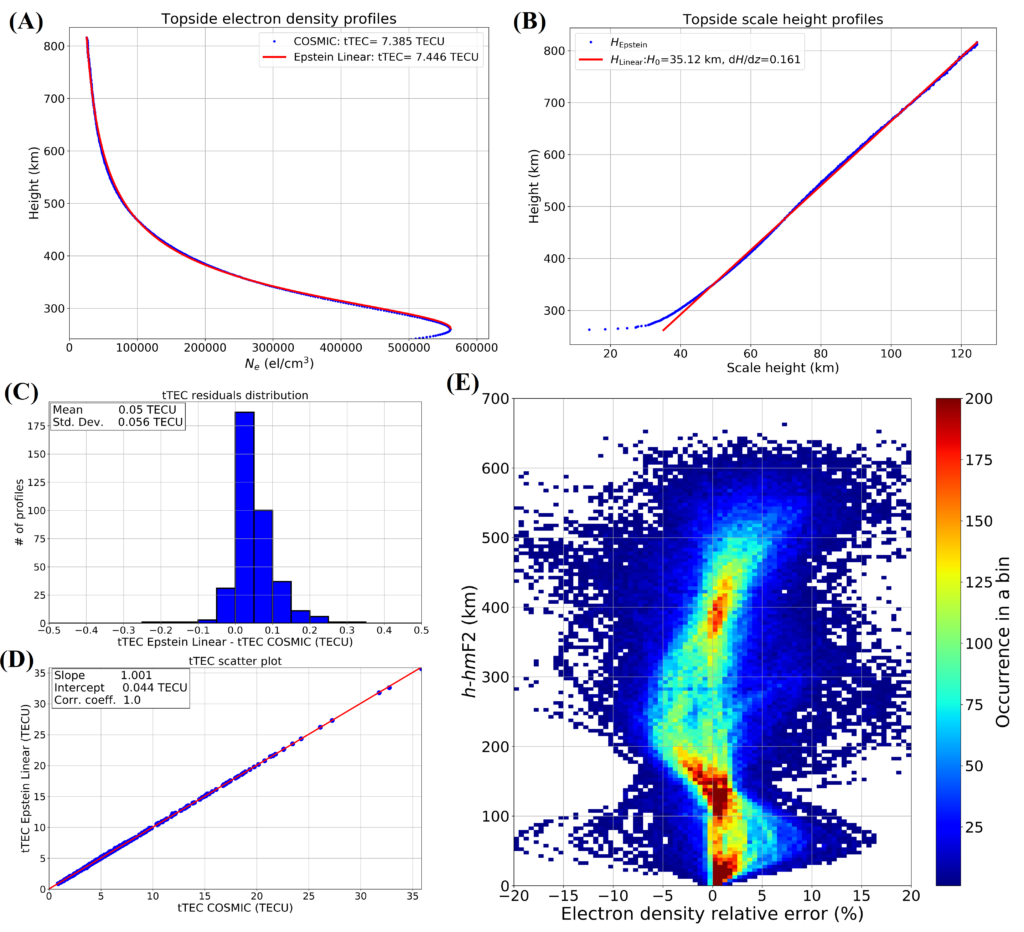
In this paper, the analytical description of the topside ionosphere included in the NeQuick model is deeply analyzed. The NeQuick modeled scale height behavior is first studied at infinity and then for the lowest part of the topside region through an expansion in Taylor series near the F2-layer peak. The significant influence of the NeQuick topside parameters in the modeling of the topside profile is investigated in detail and, in particular, it is shown that for the lowest part of the topside the model assumes a linearly increasing trend of the topside scale height. Afterwards, the NeQuick topside formulation is inverted to derive a fully analytical expression of the topside scale height as a function of the electron density and F2-layer peak parameters. This expression has been applied to a selected and very reliable dataset of COSMIC/FORMOSAT-3 Radio Occultation profiles. The performed statistical analyses strongly support the supposed linear trend of the topside scale height for the lowest part of the topside ionosphere, as embedded in NeQuick; thus, the developed technique might be relevant for Space weather modeling purposes.
Publication: A. Pignalberi, M. Pezzopane, D. R. Themens, H. Haralambous, B. Nava and P. Coïsson, “On the Analytical Description of the Topside Ionosphere by NeQuick: Modeling the Scale Height Through COSMIC/FORMOSAT-3 Selected Data,” in IEEE Journal of Selected Topics in Applied Earth Observations and Remote Sensing, vol. 13, pp. 1867-1878, 2020, doi: 10.1109/JSTARS.2020.2986683.
https://ieeexplore.ieee.org/document/9072529
The ionospheric irregularities climatology over Svalbard from solar cycle 23
Papers from SWICo members
Giorgiana De Franceschi, Luca Spogli, Lucilla Alfonsi, Vincenzo Romano, Claudio Cesaroni, Ingrid Hunstad
An unprecedented climatology of the ionospheric irregularities over the Svalbard (NO) derived from the longest Global Navigation Satellite Systems (GNSS) scintillation data series ever collected. Two receivers for scintillation monitoring are working at Ny-Ålesund, the first of which has been installed in late September 2003.

They are able to investigate auroral and cusp/cap regions and the length of the data series allows describing the Arctic ionosphere along about two solar cycles, from the descending phase of cycle 23 to almost the end of cycle 24. A detailed assessment of the long-term behaviour of the ionosphere under solar maximum and solar minimum conditions is provided including several periods of perturbed ionospheric weather caused by unfavourable heliogeophysical conditions. Since November 2015, a multi-constellation GNSS receiver has been deployed in Ny-Ålesund, providing the opportunity to perform the ionospheric climatology from Galileo signals. The results offer realistic features of the high latitude ionosphere, providing a broad spectrum of ionospheric reactions to different space weather conditions.
Publication: De Franceschi, G., Spogli, L., Alfonsi, L., Romano, V., Cesaroni, C., & Hunstad, I. (2019). The ionospheric irregularities climatology over Svalbard from solar cycle 23. Scientific reports, 9(1), 1-14.
https://www.nature.com/articles/s41598-019-44829-5
Role of the external drivers in the occurrence of low-latitude ionospheric scintillation revealed by multi-scale analysis
Papers from SWICo members
Luca Spogli, Mirko Piersanti, Claudio Cesaroni, Massimo Materassi, Antonio Cicone, Lucilla Alfonsi, Vincenzo Romano, and Rodolfo Gerardo Ezquer
By leveraging on the modal analysis provided by the Adaptive Local Iterative Filtering (ALIF) technique, this study focuses on the multi-scale variability of the amplitude scintillation on Global Navigation Satellite Systems (GNSSs) recorded over San Miguel de Tucumán (Argentina).

The site is nominally located below the expected position of the southern crest of the Equatorial Ionospheric Anomaly (EIA). The considered period is 1–31 March 2011, during which one minor and one moderate storm characterize the first half of the month, while generally quiet conditions of the geospace stand for the second half. The multiscale analysis is extended to helio-geophysical parameters to speculate on the possible relationship between forcing factors from the geospace and the ionospheric response. Resonant modes in the Akasofu (e) parameter are identified as likely related to the frequency components in the time evolution found for the amplitude scintillation index, hence modulating the scintillation itself. The analysis shows how the time-frequency structure of the amplitude scintillation can be characterized in terms of the resonant modes found in the combination of the Akasofu parameter. When assessed statistically, the proposed study can support models driven by interplanetary parameters aimed at characterizing the low latitude scintillation. The detection of resonant modes in the identified parameters can be used to define the Space Weather impact on GNSS signals recorded at ground.
Publication: Spogli, L., Piersanti, M., Cesaroni, C., Materassi, M., Cicone, A., Alfonsi, L., … & Ezquer, R. G. (2019). Role of the external drivers in the occurrence of low-latitude ionospheric scintillation revealed by multi-scale analysis. Journal of Space Weather and Space Climate, 9, A35
https://www.swsc-journal.org/articles/swsc/abs/2019/01/swsc180047/swsc180047.html
A Preliminary Risk Assessment of Geomagnetically Induced Currents over the Italian Territory
Papers from SWICo members
Authors:
Roberta Tozzi, Paola De Michelis, Igino Coco, Fabio Giannattasio
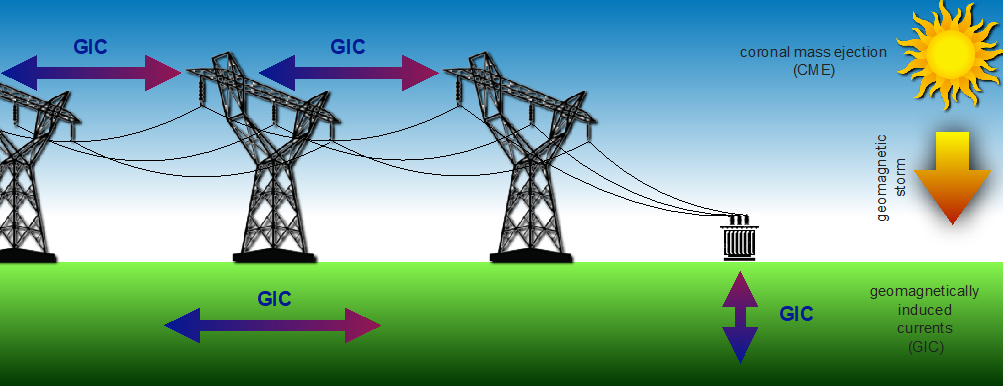
Major geomagnetic storms drive rapid intensification and variability of magnetospheric and ionospheric current systems that give rise to large ground geomagnetically-induced currents (GIC). Space weather associated GIC pose a serious threat to the reliability of power-transmission systems and other electrically conducting infrastructures such as oil and gas pipelines. The most severe effects are observed at high latitudes due to ionospheric currents associated with the aurora. However, as power transmission grid and pipeline infrastructures continue to grow at middle and low-latitudes, GIC hazards are no longer just concerns of high-latitude regions.

We provide a preliminary characterisation of the general risk to which the Italian power grid network is exposed. Due to limited direct GIC measurements, a proxy of the geoelectric field is used, i.e. the GIC index. This is calculated for a time interval of approximately 20 years using data from the two longest running Italian magnetic observatories, i.e. Castello Tesino and L’Aquila. Results show that during periods of high geomagnetic activity, potentially detrimental GICs could flow through the power network, especially at the highest Italian latitudes that are characterized by a low conductivity lithosphere.
Publication: Tozzi, R., De Michelis, P., Coco, I., Giannattasio, F., 2019. A Preliminary Risk Assessment of Geomagnetically Induced Currents over the Italian Territory, Space Weather, 17, 46-58, doi: 10.1029/2018SW002065. https://agupubs.onlinelibrary.wiley.com/doi/full/10.1029/2018SW002065
More information:
http://www.lescienze.it/news/2011/08/11/news/il_ritorno_della_grande_aurora-551058/
https://www.swpc.noaa.gov/content/education-and-outreach
Single-spacecraft Identification of Flux Tubes and Current Sheets in the Solar Wind
Papers from SWICo members
Authors:
F. Pecora, A. Greco, Q. Hu, S. Servidio, A. Chasapis, W. H. Matthaeus
In this work we present a novel technique, based on two consolidated models, for describing and visualising the local topology of the magnetic field solar wind using single-spacecraft data. The Grad-Shafranov (GS) reconstruction method provides a two-dimensional map of the magnetic field surrounding the spacecraft trajectory, while the Partial Variance of Increments (PVI) technique is able to identify coherent magnetic structures, such as current sheets. We applied this combined technique to one month of magnetic field data measured by Wind satellite at 1 AU. In this stream we selected the flux rope events, that are structures with cylindrical symmetry and a relatively strong magnetic field along the symmetry axis. These flux tubes are quite large structures (a fraction of AU) and have a complex inner structure and they interact each other while moving in the Solar Wind.
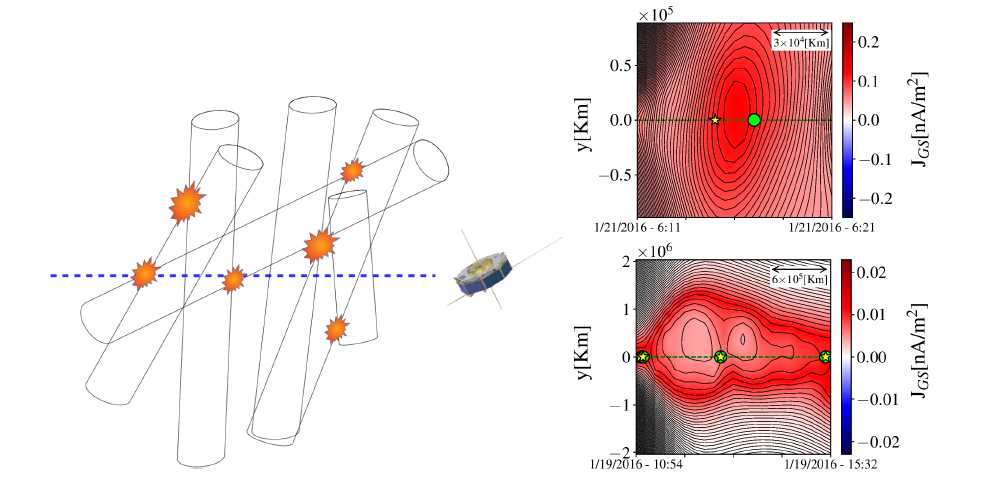
These inner and outer interactions can possibly generate sites of magnetic reconnection where strong current sheets appear. What we observed from the reconstruction is that a quasi-two-dimensional turbulence emerges as a sea of nested magnetic islands with current sheets located mostly at their boundaries. The method shows great promise for visualising and analysing single-spacecraft data from missions such as Parker Solar Probe and Solar Orbiter, as well as 1 AU SpaceWeather monitors such as ACE, Wind, and IMAP.
Publication: Pecora F., Greco A., Hu Q., Servidio S., Chasapis A. G., Matthaeus W. H., 2019, ApJL, 881, L11. doi:10.3847/2041-8213/ab32d9
https://iopscience.iop.org/article/10.3847/2041-8213/ab32d9
Forecasting the 2018 February 12th CME propagation with the P-DBM model: a fast warning procedure
Papers from SWICo members
Authors:
Dario Del Moro, Gianluca Napoletano, Roberta Forte, Luca Giovannelli, Ermanno Pietropaolo, Francesco Berrilli
The forecast of the time of arrival of a Coronal Mass Ejection (CME) to Earth is of critical importance for our high−technology society and for the Earth’s upper atmosphere status and LEO satellites. We realized a procedure based on the Drag−Based Model which uses probability distributions, rather than exact values, as input parameters, and allows the evaluation of the uncertainty on the forecast. The P−DBM belongs to a family of models that apply a somewhat simplified description of the main interaction the ICME is subject to during its interplanetary journey. The drag−based models (DBMs) assume that beyond a certain heliospheric distance, a simple aerodynamic drag equation can describe the interaction between the ICME and the solar
wind environment.

Ensemble modeling incorporate the intrinsic limitation of information due to measure errors or due to the lack of measure at all, in form of probability distributions. In practice, instead of a single run to forecast an ICME propagation, a set of runs, driven with input parameters extracted from suitable distributions are used to retrieve a distribution of output parameters. We tested this approach using a set of CMEs whose transit times are known, obtaining extremely promising results.
We realized a real−time implementation of this algorithm which ingests the outputs of automated CME tracking algorithms as inputs to provide early warning for those CME approaching Earth. We present the results of this real−time fast warning procedure for the case of the 2018 February 12th
CME.
Publication: DEL MORO, Dario et al. Forecasting the 2018 February 12th CME propagation with the P-DBM model: a fast warning procedure. Annals of Geophysics, [S.l.], v. 62, n. 4, p. GM456, dec. 2019. ISSN 2037-416X.
https://www.annalsofgeophysics.eu/index.php/annals/article/view/7750
Can superflares occur on our Sun?
Papers from SWICo members
Authors:
Paolo Romano, Abouazza Emhamdi, Ayman Kordi
Two strong homologous white light flares of X-GOES class occurred on the Sun on Sept. 06, 2017, providing a rare exceptional opportunity to study the mechanisms responsible for the formation of the magnetic field configurations suitable for the manifestation of such yet enigmatic eruptive events and their effects in the lower layers of the solar atmosphere.
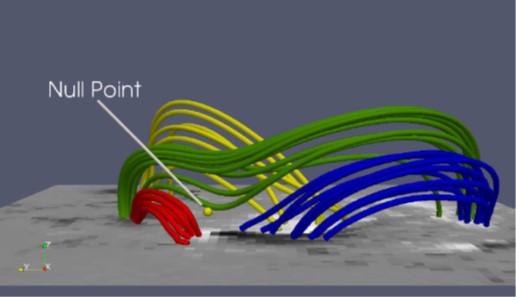
Using photospheric vector magnetograms, taken before the beginning of the two X-class events, as boundary conditions to reconstruct the non−linear coronal magnetic field configuration, we identified two related 3D null points located at low heights above the photosphere (i.e. in very low corona). These null points are most likely responsible for the triggering of the two strong X-GOES class flares. We deduced that their formation at such low altitudes may plausibly be ascribed to the peculiar photospheric horizontal motions of the main magnetic structures of the hosting Active Region NOAA 12673.
These events can be adopted as a hint for a possible interpretation of the activity of young G-type stars, recently reported by the Kepler mission, and can shed light on the probability that superflares occur on our Sun.
Publication: Two Strong White-Light Solar Flares in AR NOAA 12673 as Potential Clues for Stellar Superflares, Solar Physics, 294, 4, 2019
https://link.springer.com/article/10.1007/s11207-018-1388-0
